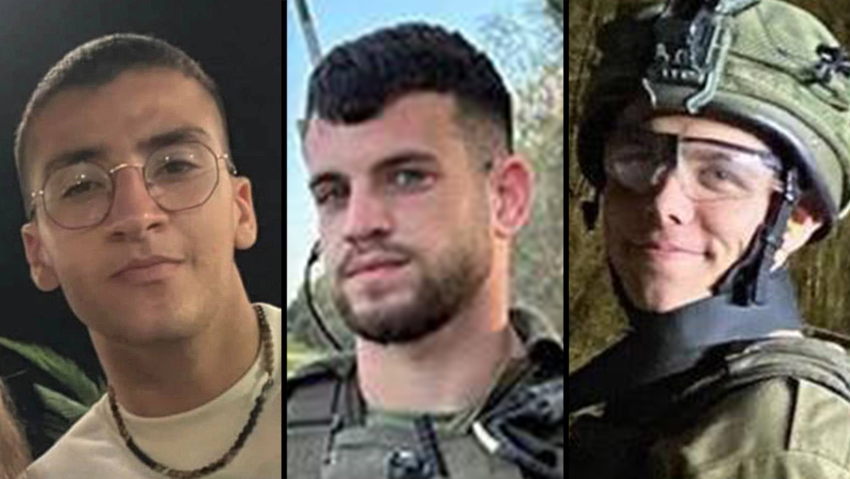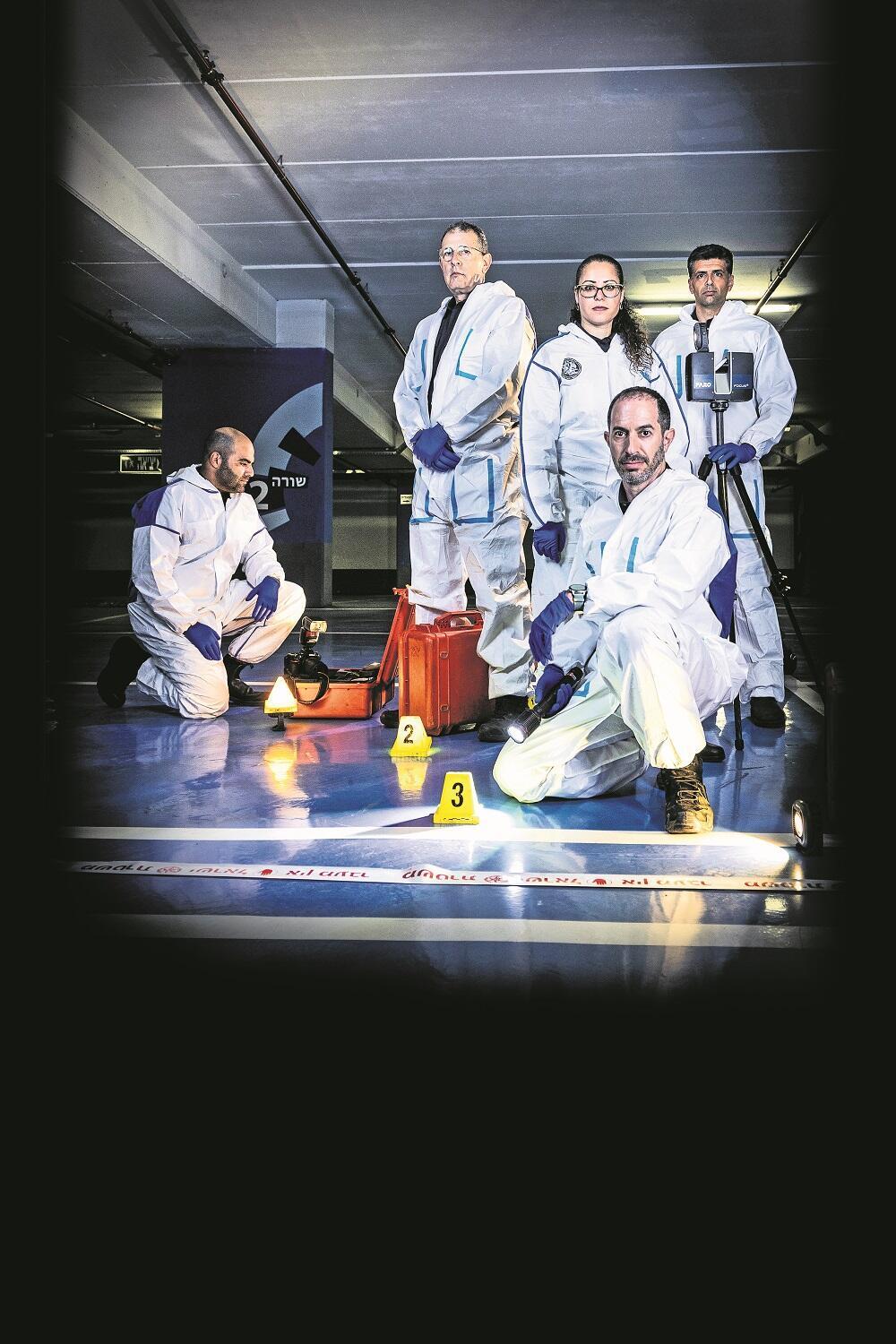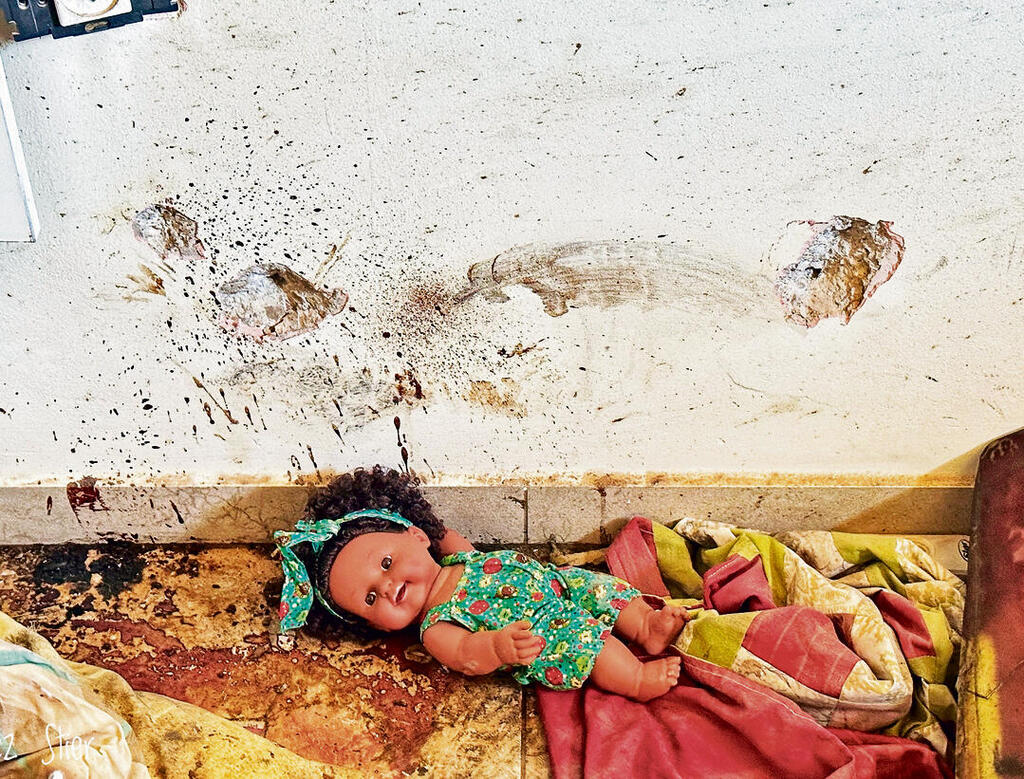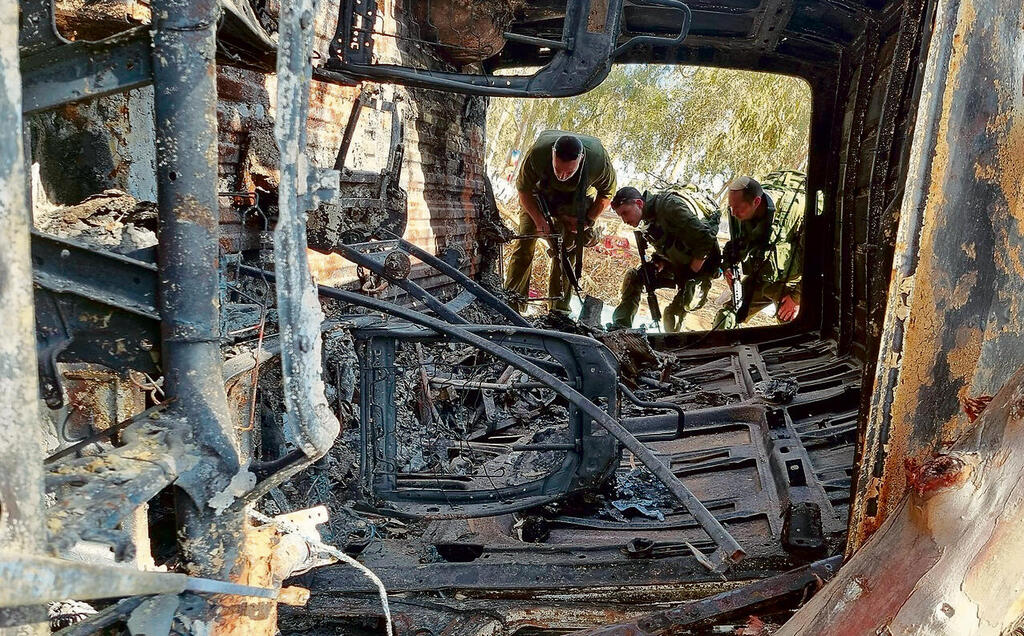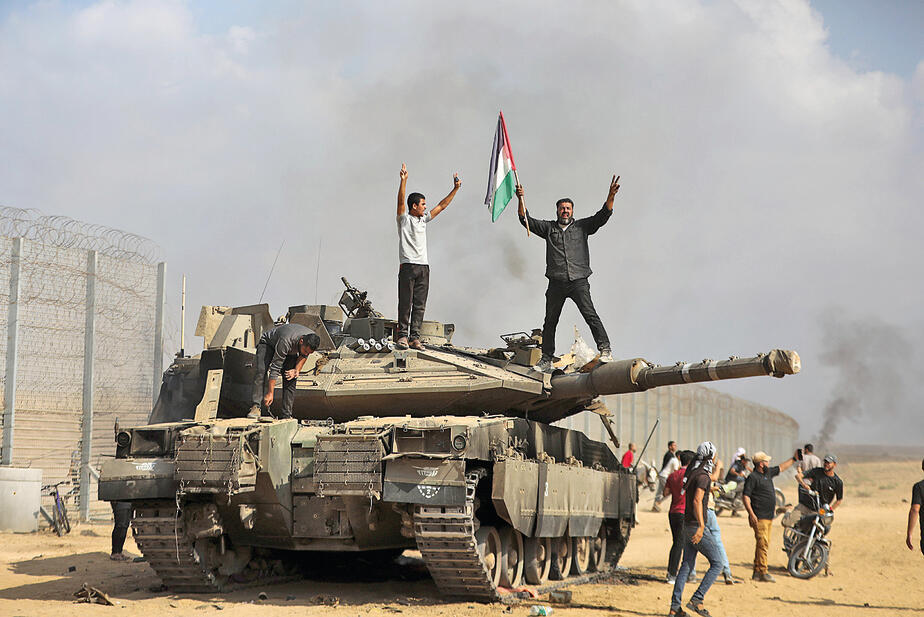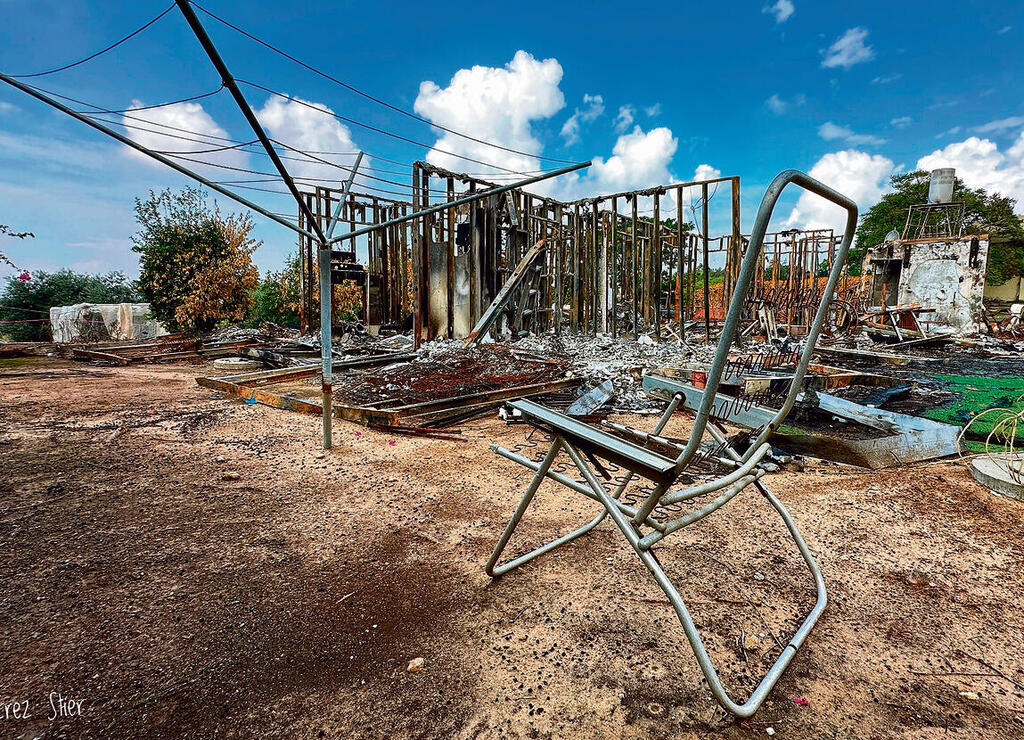Two months after October 7, intelligence led to the location of the vehicle of three soldiers who fought the battle at Kibbutz Nir Am who had been classified as missing.
Blood stains were found while searching the vehicle. Although a video clip filmed by Hamas terrorists that reached the hands of security forces, shows all three missing soldiers in the vehicle, lab tests identified the DNA of only two of the three soldiers. The IDF’s missing persons unit (Eitan) wanted to know what happened to them. Were they kidnapped alive? Were they killed and Hamas are holding their bodies in the Gaza Strip?
The police’s elite Forensic Science Department Unit’s mobile lab, which specializes in investigating and analyzing serious crime scenes, provided the answer. Since October 7, in addition to ongoing criminal murder investigations, the unit scurries from scene to scene, working around the clock, investigating the brutal crimes perpetrated by Hamas terrorists.
Chief Inspector Chen Sasson (31) from Ashkelon who’s been in the unit for four years was among the team trying to solve the mystery of the third soldier from the battle at Kibbutz Nirim. “Watching the video, we understood where each of them was sitting and we delved deep” he tells us. “We turned over all the seats and also took apart the seat that soldier was sitting in, including the upholstery and that’s where we found his bloodstains.”
How?
“Without understanding the work we do, you’d never find what we did. We have experience in locating blood, that in this case simply seeped through the vehicle’s seat upholstery. We notified Eitan that the soldier was at least injured, and that we understood all three were kidnapped to Gaza.”
After examining everything we found in the vehicle, and utilizing reliable intelligence we had, the IDF rabbinate declared the deaths of all three. Staff Sgt Tomer Yaakov Ahimas, Staff Sgt Kiril Brodski and Sgt Shaked Dahan were declared fallen soldiers whose bodies have been were taken to Gaza. The bitter news was delivered to the families 53 days after October 7.
Do you follow your work’s lab results?
“Through the news” said Ch. Insp. Sasson. “It’s very hard to hear, but at least the families now know the fate of the loved ones.”
The mobile laboratory, the police’s CSI, commanded for the past two and half years by Ch Supt Arnon Grafit (48) from Beer Yaakov, has a staff of 28. All university graduates, including scientists, chemists and experts in dealing with analyzing serious crime scene investigations make up Israel’s only team to provide this service - for the army with the Eitan unit, and for the police in collaboration with Lahav 433 investigators.
Lab personnel are divided into seven teams working across the country and are the second respondents at serious crime scenes following local forensics teams. “If there’s a body resulting from a traffic accident or suicide – they’ll take the incident” said Ch. Insp. Revital Shachar (47) from Kiryat Bialik who’s been serving at the mobile lab for five and a half years. “But if it’s murder, we’ll be there. Since October 7, they’ve been allocated further cases that may help for future hasbara. “Since the terrorist attack, we’ve been aiming to record and provide forensic evidence for investigative authorities, but more for those institutions across the globe who still refuse to believe the serious crimes committed against the People of Israel on that Black Sabbath,“ said Ch. Supt. Grafit.
Alongside the broad range of tasks all the unit’s investigators have been trained to perform, they’ve each developed unique individual expertise: Analyzing blood stains, investigating firing lines, investigating fires and arson, documenting evidence by stills or video or 3D scanning and photographing using drones and laser scanners. In recent years, this toolbox has also included a specialization called “forensic modeling” – building a 3D model of the scene using a scanner and viewing it with VR goggles.
The teams channeled their sophisticated documentation capabilities into building 3D models illustrating Hamas’s murderous violence as demonstrated at Moshav Netiv HaAsara and the Gaza border kibbutzim. In places where all that there was left were bullet holes and burnt-out remains of buildings, they can envisage the little girl hiding in a room clutching her doll, and a terrorist killing her in cold blood and even confirming the kill.
They went to one of the Gaza-border kibbutzim on October 23 as Ch. Supt. Grafit dragged the team along with him to document Hamas’s murder scenes. “We hadn’t even received proper instructions, but we understood the importance and ramifications of such documentation both for investigations and for world hasbara.”
Ch. Insp. Sasson: “We got there in head-to-toe protection, with helmets and bullet-proof vests, as RPGs were flying overhead. We went into one of the completely burnt-out homes. We walked through the living room and dining area and got to the safe room that was better preserved, but there was fire damage that had permeated into the safe room too. There was soot there and we noticed bullet holes 20-30 cm above the floor level next to spattered blood stains and the girl’s doll. From this, we deduced t that the shots were fired from low-down. It was an execution.”
How did you deduce this?
Gunfire higher up would attest to a struggle. Here we understand it was confirming a kill. We see the doll on the floor in the corner and bullet holes next to it. Three low-levels shots, and another above the electric plug outlet” explains Supt. Itzik Gilad (40) from Nofei Prat near Jerusalem who‘s been serving in the unit for five years. “The results of these shots are professionally known as ‘impact’.”
Ch. Insp. Shachar: “Impact of blood in a fan-shape on the wall for example.”
Supt. Gilad: “The small quantities of blood and stains tell us there were other shots fired. Someone was crouching on the ground and the terrorist shot a four-bullet round into him.”
Do you know where the shots were fired from?
“Yes. By our analysis, the terrorist stood in front of the safe room door. The hole from the first bullet was two meters from there, a little above the window. The victim seems to have been sitting on the bed.”
“On the window beneath the window, there’s a soot mark with ‘shading’ – i.e. where there’s no soot said Senior NCO Erez Stier (57) from Moshav Elyachin who’s been serving in the unit for two and a half years. “We can conclude that there was a child’s bed against the wall at the time of the fire when the smoke entered the room, so the bullet passed through someone sitting on the bed creating the spatter of blood and the hit on the wall.”
Do you know who the victim was?
“Only through DNA tests on blood samples.”
Ch. Supt. Grafit: “At a regular murder scene, no one touches the bodies before we show up, but here we clearly didn’t have the same forensic conditions. Soldiers and Yahalom had been in there to make sure there were no explosive devices. Zaka and others too. “
Ch. Insp. Sasson: “We built a 3D model for this house using a drone and a panoramic view camera.”
How will this model of the house help?
Senior NCO Stier: “If a captured terrorist were to claim that he didn’t mean to hit, we can tell him with certainty ‘You entered the room and shot to kill’. Some of our documentation is intended for international hasbara. There are forensic findings here that can prove what happened.”
How did you decide what to document?
Supt. Gilad: “At first, we took the initiative and documented the houses we chose. We later received instructions from the investigation units and specific questions about gunfire direction and blood stains and the fate of the missing and kidnapped individuals and various sites.”
Like everyone at 6:30 on the morning of October 7, they didn’t truly understand the magnitude of events.
“We were still in bed when our WhatsApp group went off” said Ch. Supt. Grafit. “No one understood what was going on yet. My team in the south was the first in the field. I called the commander, Supt Shay Haimov, head of our branch in the south who he told us he didn’t need backup right now” Grafit said with a bitter smile.
Ch. Insp. Sasson: “I was in the team in the south and I got there with my commander at about 7 pm after receiving a call for help in identifying bodies that had arrived at Barzilai Hospital in Ashkelon. We took with us tools for identification purposes: fingerprints, DNA, registering identifying features such as tattoos, scars, jewelry, items of clothing, shoes, photographing faces and bodies. Supt Haimov said to us ‘Come on, there are a few bodies there’. When we got here, we were horrified to find several dozen bodies in the pathology department. We set to work and it just didn’t end. More and more containers and trucks of bodies in all conditions were showing up.”
“At 9 pm, we got a call saying ‘Get yourselves to Nova’. Route 232 was dark and our Savanna got a flat tire by the Black Arrow Memorial. We stopped next to lots of burnt-out cars and there was a burnt body of a girl next to us and a car with a civilian shot in the face, a pickup truck full of ammunition and dead terrorists with green bands on their heads. We didn’t know there were still terrorists in the field. My commander and I only had pistols, and there we were, fixing a flat tire. Rockets were flying overhead and there were fires all around us.”
“When we got to Nova, I thought to myself that either snipers had been here or they’d done confirmed kills on everyone as the vast majority of the bodies had gunshots to the head. Our Savanna is equipped with strong lighting, so we saw three ambulances filled with hundreds of bodies and Zaka, MDA, Forensics and Lachish people along with volunteers. At 10 pm, we start identifying bodies as with constant suicide drone warnings around us. Two new teams showed up in the morning and we packed up at 4 am.”
Supt. Gilad: “At 4 am I got a call from Commander Grafit to go to the police station in Sderot that had been taken over by terrorists. On my way, I’m getting names of my friends, policemen and officers killed in the incident and I now had to come help identify them. Like everyone one, we saw the destruction all around, but we have our ways of looking at the scene and recreate the scenario of what happened there.”
Give me an example of such a scenario
“When we took the body of a police officer out of the police station, I notice his magazine was empty and he’d bandaged himself in several places, I could understand that he’d fought to the end like a lion, despite being injured. All his friends too.”
How do you function in a crime scene involving police officers, some of whom are your friends?
“When I’m working at a scene, I have a mask of steel. I started in Sderot, then onto Moshav Yachini and finished off at Shura. When I got home at 1 am, it all came flooding out. All the terrible things I’d seen that day. The horrors, the names. We have to process it ourselves. One of the police officers murdered at Re’im, Alon Bard, who was the subject of lots of fake news was an investigator at Rahat police station. Hearing these things was like a punch in the stomach. He was the most principled, loyal and Zionist person.”
Being used to gruesome murder scenes, were you surprised to what you saw on October 7?
“We’re used to seeing cruel, tough stuff, but the volume on October 7 was astronomical.”
Ch Supt Grafit: “Everything we saw there, we’d seen before. We saw murdered babies, cases of rape and body dismemberment, arson and beheading, but not in these numbers and not at such a concentration. Not only was the volume unimaginable, it kept going up. Zoglovek and Yotvata (freezer) trucks showed up with piles of hundreds of bodies to be brought out and sorted. When you have a case like the Oshrenko family, who were all burned alive (the family of six members was murdered by Damian Kerlik who broke in their Rishon LeZion apartment), you know it’s a lone psychopath. Here, you realize the whole country is under existential threat.”
Meanwhile as his unit colleagues were working in the field, Commander Shachar tells us how she begged Grafit, her commander, to let her onto the scene, but he wouldn’t. “I realized the incident would take a very long time and I didn’t want to send everyone out at once” Grafit explains with a smile. I’ve got wild horses who all want to run ahead and I need to rein them in.”
Two days later, she also joined her colleagues at Shura. “The police weren’t prepared for the insane number of bodies,” she said. “So, we put the trucks in the sandy parking lot on base, got up on the ramp and worked with flashlights on our heads inside the trucks, documenting and allocating each body a number. I worked for six weeks at Shura during which time, I was also called out to deal with five criminal murder cases. Senior NCO Erez Stier cut his Cyprus vacation short on Tuesday and got himself straight to Shura.”
Among the horrors around Moshav Tkuma, there was a private ambulance that had been ordered ahead of time by the organizers that we found overturned and totally burnt out. The investigators received information that there were at least 16 bodies of party attendants inside, including members of the medical team and injured people who had found cover beneath the ambulance, hiding from the gunfire.
Chief Inspector Shahar: “We were asked to investigate the ambulance to understand what happened there. What hit it? Who was in it?”
Why was it overturned? Was there an accident? Was it shot at?
“It was overturned because the rescue services had tried to extract the bodies.”
Ch. Supt. Grafit: “As we found the ambulance hidden among the trees, we thought maybe people had been trying to hide inside the ambulance, or perhaps the terrorists killed them, loaded the bodies onto the ambulance and set fire to it.”
And what actually happened?
“We discovered the ambulance had been hit by an RPG that set it on fire and the ambulance and everyone inside didn’t stand a chance. All we could do was find the remains of the victims and try to identify them. This is how we found the famous ring of the festival DJ (Matan Elmalam, known by his stage name DJ Kido, one of Israel’s leading trance DJs). It came as terrible news to the family, but at least they knew what happened to him. Some still don’t know.”
The video clip of Hamas terrorists celebrating on an IDF Merkava tank that was set on fire by the fence on October 7, has been ingrained in collective memory as a symbol of defeat that day. At the request of an Eitan officer, a team was sent to investigate what happened there and what happened to the soldiers. Were they killed or kidnapped alive?
Supt. Gilad: “This tank had already been checked once by the army, and we went to find out what happened. We knew the tank was hit by an RPG as we saw the damage on its front and we understood that shots were then fired from turret inwards.”
What does that mean?
“There were terrorists there with Kalashnikovs, shooting 7.62 mm bullets. The terrorist, or terrorists climbed onto the roof of the tank, opened the top window and from the turret, shot inside the tank from above. There were four soldiers inside. We took biological samples and sampled the blood.”
Ch. Insp. Shachar: “They shot a number of bullets from the turret window straight at the tank commander’s seat. There’s a hole going through the seat into the body of the chair all the way through to the floor.”
Supt. Gilad: “A bullet like this, travels at 9601 meters per second. Everyone there was hurt. We concluded that all four were kidnapped to Gaza. The bodies of two are being held by Hamas and the other two are alive.”
A security squad member on one of the kibbutzim bravely fought dozens of terrorists who had infiltrated the kibbutz, to protect the residents besieged in the safe rooms for over 14 hours. The team was called in to help provide information about what happened to him and to another kibbutz security team member classified as missing.
Ch. Insp. Sasson: “At the Eitan unit, we were told there was a video from one of the terrorists’ cameras where you can see the kibbutz security team. We know he was kidnaped to Gaza but we wanted to find out whether he was taken alive or murdered and that his body is being held by Hamas.”
And how do you check this?
“We went to the scene on a pathway outside his home. The video from the terrorist’s camera shows precisely where the security team member was. There were blood stains at that very spot on the ground. We needed to work out whether or not we’re talking about a body.”
And what did you find out?
“We saw bloodstains where his head had been, indicating gunfire to the head from a low level. Our gunfire specialist determined that in all likelihood, he isn’t alive and his body was taken to Gaza.”
How does the information get to you?
“There’s intelligence information all the time from investigating terrorists or from hostages’ possessions our soldiers find in Gaza, or the SUVs the terrorists likely took the hostages to Gaza with bloodstains by which we need to find out whether they were injured or killed. Blood stains don’t have an ‘expiration date’. We diligently search for blood and DNA remains to ascertain to whom they belong.”
Ch. Insp. Shachar: “We’re constantly getting requests about various people, asking us to check whether they’re kidnapped or alive, injured or dead. We do lots of work for both the police and the army. Using the information we give them, they can direct forces to operate where needed.”
One thing’s for sure: On October 7, artist Bilha Yinon and her late husband Yaakov were at their home on Moshav Netiv HaAsara. Bilha (76) spoke to her family from the safe room. When the terrorists infiltrated the moshav, they set fire to the couple’s home, burning it to the ground, but only the husband’s DNA was found at the burnt-out scene and no forensic remains for Bilha were found. In the chaos ensuing October 7, Bilha was also declared dead. And now, four months after the family sat shiva for her, the army is insisting on retaining her status as missing and concerns have arisen regarding her condition. Is she alive? Kidnapped?
To try and find out what exactly happened in the couple’s home, Senior NCO Stier from the mobile lab was called in along with his colleagues to try and solve the mystery. “I checked the spot where the fire started, its source,” he said. “Fire has its own language, based on ‘combustion patterns’ of soot by which we can tell what happened. Where the fire started, where the fire was stronger or weaker and what caused it. Was it deliberate arson or was the house hit by an RPG? Maybe the fire resulted from an explosive device. The closer you get to the source of the fire the more prominent the soot marks. The further away, the weaker.
What did you find out?
“This house had already been investigated those conducting the investigation believed the fire was started from inside the safe room where the woman was hiding, so that’s where they conducted all their searches. When we arrived at the scene, we realized the fire hadn’t started in the safe room as items were found in the safe room that weren’t burnt and property that had been burnt to a lesser extent than items were found in other parts of the apartment outside the safe room. By the weaker soot and smoke marks around the safe room window and around the door, we deduced that the door and window had been closed, so the fire didn’t start there, but rather outside. The information we passed on to the investigation teams was that there was no need to check the safe room.”
What does that mean?
“What we were actually telling them was that they needn’t waste their time and manpower there, but rather focus their searches for her elsewhere. Analyzing serious crime scenes also involves ruling out initial lines of investigation. If the investigators know where the fire didn’t start, they can concentrate their efforts looking for it somewhere else.”
Supt Gilad: “In addition to Stier’s test, I also conducted a BlueStar test to decipher blood stains. This is a transparent chemical liquid that turns blue upon contact with blood. It’s used to help detect traces of blood.”
So, where’s Bilha?
Ch. Insp. Sasson: “Still classified as missing.”
In the past, the unit ruled out finding missing persons in places others had already searched. “Two months after October 7, a burnt-out car found by the roadside was towed to Moshav Tkuma” said. “They knew there had been three people there – two bodies found in the car and the third was classified as missing and for months, no one knew what happened to her. They asked us to try and find her to understand whether she was injured, kidnapped or killed.”
And what came up from checking the vehicle?
“After detailed tests, we didn’t find any traces of human remains. I’ve no idea what happened to her, but I told the investigators not to put themselves out looking for her in the car. That was my answer.
Although they say they’ve seen it all, they say that working on the October 7 scenes has changed them. Ch. Supt. Grafit admits to having become more fearful. “Unlike a regular person who sees what they see, when I enter a scene in a home, in my mind’s eye, I see a movie of what happened there” he said. “I see signs of Kalashnikov fire from the safe room inwards to the room and understand that someone tried protecting their family with a pistol, and lost. I understand he shot out with the pistol. I imagine him in the safe room, returning fire from the doorway. I think to myself ‘In his position, would I have fired my last five bullets at the terrorists or my family?”
“After everything I saw, I added bolts to my safe-room door and got another dog to protect the house. I have an existential fear for myself, my family and my country.”
Ch. Insp. Shachar: “The hardest thing for me is that moment when you open a bag and take out a body and you don’t know what you’ll find. Some such moments stay with you. I once took out a body with a bullet-proof vest, a gun and a helmet. It was a security team guy. Or you get the naked body of a young woman with her hands and feet bound with the cord of an electric kettle. You immediately realize she was first stripped naked before she was bound. You can’t take a woman’s clothes off her if her hands and feet are tied. There was also the body of an older woman. I’ll never forget. She’d been gathered into the body bag with her bag hanging across her body and her spectacles hanging around her neck. You realize she was murdered as she was trying to escape.”
Supt. Gilad: “At the scene, you’re on autopilot. You only feel that kick to the stomach afterward. Ynet had a ‘body count’. When I got to Shura, it stood at 150. I then saw six Yotvata and Zoglovek trucks. One of them had 200 bodies. You just can’t take it all in.”
Ch. Supt. Grafit: “Thirty percent of our people have sought mental health treatment.” Supt. Gilad: “I wish we could freeze time to October 7 so we could go house to house and investigate every scene in depth. And with all this, we’re proud of our professional capabilities and what we’ve managed to achieve. Despite everything.”
First published: 00:57, 06.29.24



